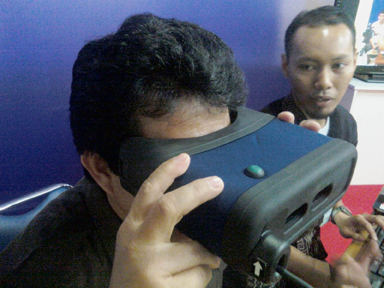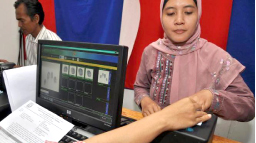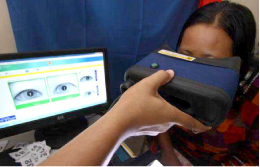Over the past year we have been following the roll-out of one of the world’s most ambitious biometrics-based national identity card projects – Indonesia’s eKTP program. We now checkpoint the latest status and take a look at what industry watchdogs are saying about its progress and potential
by Victor March
 According to recent reports, the Indonesian Home Ministry has said that the government is expecting for additional contracted work to finish on the manufacture and issuance of electronic identity cards for its massive national identity program This involves the issuance of cards to 172 million residents, following biometric enrolment across the country’s multiple regions and islands.The Ministry stated the State Printing Consortium Company (PNRI) has yet to manufacture 12 million cards and has more than 48 million left for printing. The contract has now been extended to Oct. 2013.
According to recent reports, the Indonesian Home Ministry has said that the government is expecting for additional contracted work to finish on the manufacture and issuance of electronic identity cards for its massive national identity program This involves the issuance of cards to 172 million residents, following biometric enrolment across the country’s multiple regions and islands.The Ministry stated the State Printing Consortium Company (PNRI) has yet to manufacture 12 million cards and has more than 48 million left for printing. The contract has now been extended to Oct. 2013.
The government has obtained 110 million of printed eID cards, and has distributed 90 million to Indonesian citizens and residents. These cards, called Kartu Tanda Penduduk Elektronik, or eKTP for short, will be used for voter registration, passport issuance, tax payments and to verify identity for social insurance in the country. Technology for this project was supplied and implemented by a wide range of firms including L-1 Identity Solutions, HP, Topaz Systems and Biomorf.
Most advanced adopter
A recent assessment by the Biometrics Research Group has identified Indonesia as the most advanced adopter of eID credentials. This stated the exercise required an intensive operation involving card manufacturing and chip encoding machines running 24 hours a day, outputting close to 8,000 cards per day.
Implementing a biometrically-enabled identification card in Indonesia, the country with the fourth largest population, has been a vital step in creating a nationwide identification infrastructure which embraces and enhances a number of applications, including e-government, financial projects and social services.
The Indonesian government committed US$600 million to provide a national identity card to all of its 172 million residents.
Using contactless smart card technology, eKTP obligates every citizen to have his or her fingerprints scanned, verified, and saved in a central database. The projecthas already seen all Indonesian residents having submitted for biometric registration.
The Indonesian Home Ministry reported in late 2012 that the government had achieved its objective to migrate all 172,015,400 Indonesians with a regular government-issued ID card, or KTP, to the new electronic version.
The logistical challenges were comprehensive, and included training approximately 72,000 employees to operate biometric equipment, and requiring them to work in at least 7,000 locations in a country that has 746 languages used by 1,128 distinct ethnic groups, who mainly live scattered throughout 77,088 villages.
Elections
With the registration of nearly all of the country’s residents, the government states it can now proceed with using the card to ensure the integrity of upcoming national elections in 2014. The other main reasons for implementing the new e-KTP credential were to enhance national security and reduce social assistance fraud.
With the new cards, the Indonesian government intends to reduce the risk of terror attacks. In the past, terrorists operating in the country had been found holding falsified KTP documents.
But with the new smartcard technology, the government claims that eKTP credentials are virtually impossible to forge. As a result, they should not be subject to misuse by criminals and terrorists, who have been known to evade capture through the use of fake or multiple KTPs.
 The streamlined biometric registration process that allowed the government to issue all the new eID cards before the 2012 year-end deadline not only demonstrated efficiency. The new system also allowed the government to complete instantaneous verification checks, thereby flagging instances of residents who attempted to register multiple times for an eKTP credential.
The streamlined biometric registration process that allowed the government to issue all the new eID cards before the 2012 year-end deadline not only demonstrated efficiency. The new system also allowed the government to complete instantaneous verification checks, thereby flagging instances of residents who attempted to register multiple times for an eKTP credential.
National security
The elimination of multiple registrations substantially lowers the risk of multiple cards being used by terrorists to confound Indonesia’s national security establishment or by fraudsters attempting to abuse the country’s roster of social welfare benefits.
With the completion of biometric registration for all the country’s citizens, Indonesia has achieved a high level of identification verification for its citizens, employees and even political class.
Prevent misuse
Previously, the government successfully deployed electronic ID cards for use by the entire civil service. The civil service eID cards were enhanced with fingerprint biometrics and are designed to control the issuance and prevent misuse of benefits granted to Indonesian government employees.
The cards are also multi-purpose, acting as a reliable authentication method for other application areas including health insurance, housing subsidies, and pension funds.
Authenticity
It was noted by the Biometrics Research Group (BRG) that adoption of enhanced civil service cards with biometrics significantly enforces identification procedures and increase ID card authenticity, thus eliminating potential abuses and misapplications.
At the political level, even lawmakers agree with this sentiment, according to reports. BiometricUpdate.com reported that the House of Representatives in Jakarta, Indonesia spent US $29,295 on the installation of biometric fingerprint scanners to track the attendance of lawmakers.
According to BRG, the purpose of implementing the biometric system at the legislature was to minimize truancy. The absence of lawmakers during hearings had been a major issue for Indonesia’s House of Representatives.
Despite not attending, the names of many legislators were still recorded on attendance lists. The use of biometrics aims to correct this issue by placing greater scrutiny on elected officials, just as its use with civil service is aimed to ensure that employment benefits are not abused.
With these multiple initiatives, BRG states it is quite safe for to assess Indonesia as the world’s most advanced adopter of eID credentials and technologies by way of the depth of deployment throughout multiple sectors of its society and economy.
Architecture
The national ID system is a distributed system, which is modular, highly flexible and scalable with plug and play architecture and can be easily deployed on any large-scale systems. It provides great flexibility in the form of using any Biometric SDK/Search Engine/Biometric Capture devices. This system was designed to enroll a total population of 172 million civilians with:
- 1 central site
- 500 regional sites
- 7000 local sites (14000 enrollment Stations) and
- Mobile Registration Sites (1000 Enrollment Stations).
In summary, according to vendors involved, the goals of the program included the distribution of social services, equitable taxation base, student cards and voters registration system; a national silo of unique identities; a separate gallery for serving criminal investigation and physical identification in various programs.
Standard formats
All the data is stored in standard formats and compressed using certified standard algorithms such as WSQ, PNG and JPEG. Customer has full ownership of the data as it is stored at customer facility. Data can be exported to ISO standards when required.
Local set up
The local site is set up as follows:
- 1 server and 2 client
- client machine consists of client applications like BEnroller, BIET, Local server backup utility
- server contains SIAK database and IDMS
- Java Daemon to push enrollment data to the central MQ Web services.
Regional set up
The regional site has 1 server with:
- SIAK
- local IDMS
- regional IDMS
- BMW (BioMoRF Middle Ware) Server
- 1 ABIS Server
- the data at this site will be in synch with the central data
- client for FP search using slaps.
Central set up
The central site includes:
- MQ Server to host queues for Central, Regional and Local Sites to publish and consume data
- BMW OLTP Servers to consume and process MQ requests
- ABIS for de-duplication of enrollments
- adjudication server to distribute the adjudication enrollments among adjudication experts
- adjudication clients for experts to perform manual validation
- adjudication Database to store the adjudication enrollments
- SIAK to store the demographic data along with status of enrollment
- IDMS to store the demographic and biometrics data of identities centrally.
Enrolment process
Retrieval of demographic data from the SIAK database and validating data:
- capture Face, Signature, Finger prints (flat), Iris Images using Biometric capture device
- provide Facial extraction and Image enhancement using Biometric SDK
- segment the captured Slaps and do sequence check and quality analysis using Biometric SDK
- provide Iris Segmentation and Quality analysis using Biometric SDK
- provide Localization support and printing capability
- export all the captured data into a standard NIST file and submit to the workflow Engine for de-duplication or save locally.
Card management
The card management client is used for eKTP card encoding and printing civilian cards and this application is intended for the encoding and printing of the eKTP card:
- able to support multi language
- provide an option to view all demographic, photo and signature for selected record of the civilian.
- provide an option to update the status in the database as ‘Card Printed’
- enabled card management, to fetch the configurable number of records from the database.



